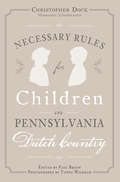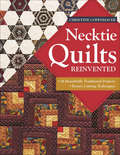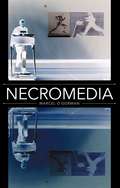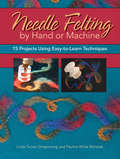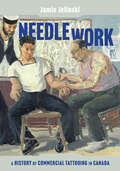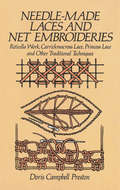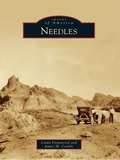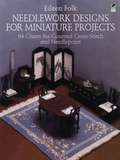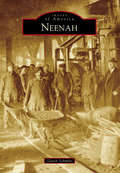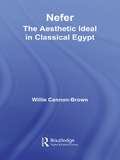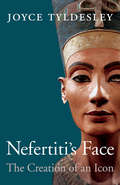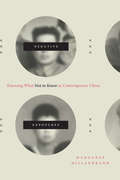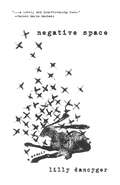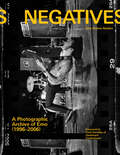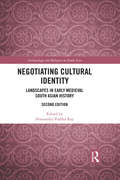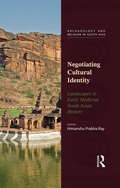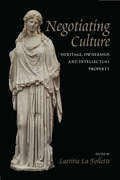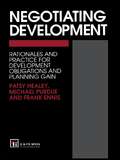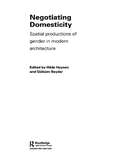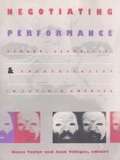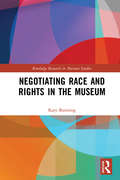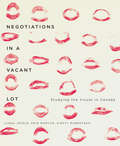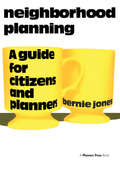- Table View
- List View
Necessary Rules for Children in Pennsylvania Dutch Country
by Christopher DockMennonite schoolmaster Christopher Dock first published his A Hundred Necessary Rules of Conduct for Children in 1764. It instructed children how to keep their belongings tidy, behave in public and stay awake in church. While even the best-behaved Mennonite boy couldn't resist the allure of a well-placed puddle, the schoolmaster laid out helpful guidelines. Schoolteacher Paul Breon brings the rules into context for today's children and parents in Necessary Rules for Children in Pennsylvania Dutch Country, with charming period photography by Tonya Wilhelm. Rediscover timeless wisdom in the first guide to etiquette published in the American colonies.
Necktie Quilts Reinvented: 16 Beautifully Traditional Projects * Rotary Cutting Techniques
by Christine Copenhaver“New ideas for quilting with ties . . .projects include covers, wall-hangings, runners, and pillows.” —Publishers WeeklyAs life gets less formal, neckties don’t get worn like they used to, leaving us with a stash of unused ties. Recycle those lonely ties into 16 spectacular quilts and home accessories that look nothing like the typical stodgy necktie quilt! Showcase the rich colors, patterns, and textures found in ties with striking Hexagons, Log Cabins, Lone Stars, Flying Geese, and more. Learn how to wash ties, cut them, create appealing color combinations, and tame slippery fabric for quilting. Tie quilts make uniquely personal Father's Day, birthday, or any-occasion gifts for the tie-wearers (or former tie wearers) in your life—and this book is filled with projects for both beginners and experienced quiltmakers.
Necromedia (Posthumanities #33)
by Marcel O'GormanIn Necromedia, media activist Marcel O&’Gorman takes aim at &“the collusion of death and technology,&” drawing on a broad arsenal that ranges from posthumanist philosophy and social psychology to digital art and handmade &“objects-to-think-with.&” Throughout, O&’Gorman mixes philosophical speculation with artistic creation, personal memoir, and existential dread. He is not so much arguing against technoculture as documenting a struggle to embrace the technical essence of human being without permitting technology worshippers to have the last word on what it means to be human.Inspired in part by the work of cultural anthropologist Ernest Becker, O&’Gorman begins by suggesting that technology provides human beings with a cultural hero system built on the denial of death and a false promise of immortality. This theory adds an existential zest to the book, allowing the author not only to devise a creative diagnosis of what Bernard Stiegler has called the malaise of contemporary technoculture but also to contribute a potential therapy—one that requires embracing human finitude, infusing care into the process of technological production, and recognizing the vulnerability of all things, human and nonhuman. With this goal in mind, Necromedia prescribes new research practices in the humanities that involve both written work and the creation of objects-to-think-with that are designed to infiltrate and shape the technoculture that surrounds us.
Needle Felting by Hand or Machine: 20 Projects Using Easy-to-Learn Techniques
by Linda Griepentrog Pauline RichardsMachine felting is one of the hottest things in fiber arts, building on the rich history of hand felting. With top sewing manufacturers adding felting accessories to their lines, sewers can look to this new guide to efficiently explain this history of this practice and demonstrate the unique felting techniques which use moisture, pressure and abrasion to bind fibers together. Be inspired by the exciting projects to create felted items for the home, wardrobe and to give as gifts.
Needle Work: A History of Commercial Tattooing in Canada (McGill-Queen's/Beaverbrook Canadian Foundation Studies in Art History #44)
by Jamie JelinskiIn 1891 J. Murakami travelled from Japan, via San Francisco, to Vancouver Island and began working in and around Victoria. His occupation: creating permanent images on the skin of paying clients.From this early example of tattooing as work, Jamie Jelinski takes us from coast to coast with detours to the United States, England, and Japan as he traces the evolution of commercial tattooing in Canada over more than one hundred years. Needle Work offers insight into how tattoo artists navigated regulation, the types of spaces they worked in, and the dynamic relationship between the images they tattooed on customers and other forms of visual culture and artistic enterprise. Merging biographical narratives with an examination of tattooing’s place within wider society, Jelinski reveals how these commercial image makers bridged conventional gaps between cultural production and practical, for-profit work, thereby establishing tattooing as a legitimate career.Richly illustrated and drawing on archives, print media, and objects held in institutions and private collections across Canada and beyond, Needle Work provides a timely understanding of a vocation that is now familiar but whose intricate history has rarely been considered.
Needle-Made Laces and Net Embroideries: Reticella Work, Carrickmacross Lace, Princess Lace and Other Traditional Techniques (Dover Knitting, Crochet, Tatting, Lace Ser.)
by Doris Campbell PrestonReticella work, carricmacross lace, princess lace, and other traditional techniques developed by lace-makers in Ireland, England, Spain, and other countries resulted in finished pieces of unrivaled beauty that continue to inspire needlecrafters. Now needleworkers can learn to make exquisite lace and net embroidery in styles that originated in the centuries-old lace-making centers of Europe.This volume is a classic guide to the single-thread-and-needle styles of lace-making: complete instructions and clear stitch diagrams explain how to make both needle-run and needlepoint laces. In sections of their own, tatting and Irish crochet receive the same clear treatment. Even the fascinating history of lace-making is covered in some detail, and excellent advice on the care of lace is given in conclusion.With this versatile sourcebook for reference, you, too, can create the special pieces of a lifetime: bridal veils, elegant gowns, shirts and blouses, shawls, scarves, curtains, table and bed linens. Among the lovely lace and net embroidery designs in this easy-to-follow guide, you'll find geometrics, florals, sprays, lovers' knots and other pattern classics. The lace-making art is not lost, just waiting to be rediscovered in this wonderful volume and revived in your capable hands.
Needles
by James M. Conkle Linda FitzpatrickNeedles is located at the borders of California and Arizona on the west bank of the Colorado River, once serving as an important transportation hub in California. During the mid-1800s, the steamboat trade flourished here as gold, silver, goods, and passengers were transported along the Colorado River. The Atlantic and Pacific Railroad, now known as the Santa Fe, replaced the steamboats when tracks were laid through the area starting in 1883. The charter city was founded in 1913. America's "Mother Road," Route 66, built through downtown Needles in 1926, spurred growth as new businesses opened to serve travelers. Needles was named for its striking rock formations and is famous for its summer temperatures, but it is ultimately known and remembered as a living icon of an early 20th century town on historic Route 66.
Needlework Designs for Miniature Projects: 64 Charts for Counted Cross-Stitch and Needlepoint
by Eileen FolkThink small ... beautiful things come in miniature sizes. With this collection of over five dozen charted designs, miniature enthusiasts and needleworkers can delight in creating a panoply of Lilliputian-sized heirlooms at a fraction of store prices. Here is a treasury of decorative projects to enhance and enliven any miniature setting.Accomplished craftswoman Eileen Folk offers 64 designs that will turn ordinary dollhouse rooms into exquisite showplaces with a minimum of effort and a maximum of style. These elegant projects work up quickly -- some in as little as one hour from start to finish. All can be worked in either needlepoint or counted cross-stitch and are fully complemented by easy-to-follow directions and clear, well-rendered charts. Use suggested colors or select your own color scheme in creating a variety of attractive furnishings: rugs, pillows, upholstery, chair cushions, quilts, decorative accent pieces, place mats, window treatments, bedspreads, and even an entire nursery.The book offers both beginners and experienced needlecrafters endless hours of pleasure and unlimited creative inspiration. This charming, imaginative craft book will help you create an enchanting décor for any miniature vignette.
Neenah
by Gavin SchmittNeenah rests in the heart of the Fox Valley, positioned between Appleton and Oshkosh. The city sits at the junction of Lake Winnebago and the Fox River, which has always been central to its draw for both recreation and business. Flour and paper milling utilized the river's powerful flow and brought Neenah's biggest booms. The successes of paper mills such as Neenah Paper, which opened in 1866, and the Kimberly-Clark Corporation, which opened in 1872, led to the natural development of the "Paper City" nickname. Today, industry continues to flourish in Neenah. The region has become a hub for several major corporations with broad, international reach, yet lifelong residents remain the true community heroes. Vintage photographs highlight the notable lifestyles of Bergstrom, Aylward, and Mahler, as well as the day-to-day activities of shopkeepers, churchgoers, factory workers, teachers, deliverymen, bankers, politicians, craftsmen, and other locals who were better known as friends or neighbors. Featuring both the storefronts and aisles of popular establishments such as Krueger Hardware, Jandrey's department store, and Burts Candies, this book invites readers to take a trip down memory lane. ?.
Nefer: The Aesthetic Ideal in Classical Egypt (African Studies)
by Willie Cannon-BrownThis book provides an original treatment of the concept of good and beauty in ancient Egypt. It seeks to examine the dimensions of nefer, the term used to describe the good and the beautiful, within the context of ordinary life. Because the book is based upon original research on ancient Egypt it opens up space for a review of the aesthetics of other African societies in the Nile Valley. Thus, it serves as a heuristic for further research and scholarship.
Nefertiti’s Face: The Creation of an Icon
by Joyce TyldesleyLittle is known about Nefertiti, the Egyptian queen whose name means “a beautiful woman has come.” She was the wife of Akhenaten, the pharaoh who ushered in the dramatic Amarna Age, and she bore him at least six children. She played a prominent role in political and religious affairs, but after Akhenaten’s death she apparently vanished and was soon forgotten. Yet Nefertiti remains one of the most famous and enigmatic women who ever lived. Her instantly recognizable face adorns a variety of modern artifacts, from expensive jewelry to cheap postcards, t-shirts, and bags, all over the world. She has appeared on page, stage, screen, and opera. In Britain, one woman has spent hundreds of thousands of pounds on plastic surgery in hope of resembling the long-dead royal. This enduring obsession is the result of just one object: the lovely and mysterious Nefertiti bust, created by the sculptor Thutmose and housed in Berlin’s Neues Museum since before World War II. In Nefertiti’s Face, Egyptologist Joyce Tyldesley tells the story of the bust, from its origins in a busy workshop of the late Bronze Age to its rediscovery and controversial removal to Europe in 1912 and its present status as one of the world’s most treasured artifacts. This wide-ranging history takes us from the temples and tombs of ancient Egypt to wartime Berlin and engages the latest in Pharaonic scholarship. Tyldesley sheds light on both Nefertiti’s life and her improbable afterlife, in which she became famous simply for being famous.
Negative Exposures: Knowing What Not to Know in Contemporary China (Sinotheory)
by Margaret HillenbrandWhen nations decide to disown their troubled pasts, how does this strategic disavowal harden into social fact? In Negative Exposures, Margaret Hillenbrand investigates the erasure of key aspects of such momentous events as the Nanjing Massacre, the Cultural Revolution, and the Tiananmen Square protests from the Chinese historical consciousness, not due to amnesia or censorship but through the operations of public secrecy. Knowing what not to know, she argues, has many stakeholders, willing and otherwise, who keep quiet to protect themselves or their families out of shame, pragmatism, or the palliative effects of silence. Hillenbrand shows how secrecy works as a powerful structuring force in Chinese society, one hiding in plain sight, and identifies aesthetic artifacts that serve as modes of reckoning against this phenomenon. She analyses the proliferation of photo-forms—remediations of well-known photographs of troubling historical events rendered in such media as paint, celluloid, fabric, digital imagery, and tattoos—as imaginative spaces in which the shadows of secrecy are provocatively outlined.
Negative Space (SFWP Literary Awards)
by Lilly DancygerDespite her parents' struggles with addiction, Lilly Dancyger always thought of her childhood as a happy one. But what happens when a journalist interrogates her own rosy memories to reveal the instability around the edges? Dancyger's father, Joe Schactman, was part of the iconic 1980s East Village art scene. He created provocative sculptures out of found materials like animal bones, human hair, and broken glass, and brought his young daughter into his gritty, iconoclastic world. She idolized him—despite the escalating heroin addiction that sometimes overshadowed his creative passion. When Schactman died suddenly, just as Dancyger was entering adolescence, she went into her own self-destructive spiral, raging against a world that had taken her father away. As an adult, Dancyger began to question the mythology she'd created about her father—the brilliant artist, struck down in his prime. Using his sculptures, paintings, and prints as a guide, Dancyger sought out the characters from his world who could help her decode the language of her father's work to find the truth of who he really was.
Negatives: A Photographic Archive of Emo (1996-2006)
by Amy Fleisher MaddenA gorgeous hardcover time capsule of the emo music scene as it was from 1996 to 2006, featuring never-before-seen photographs and never-before-told stories from key emo musicians, photographers, and icons.While the term emo has become a familiar label, there was a time when that wasn’t the case. Many bands of the mid-to-late '90s would never have classified themselves as such. With the advent of the 2000s, the previously underground emo scene was put on the map, and the term and sound of the genre morphed into something new. Today, the musical and cultural impact of this movement is alive and well, responsible for some of the biggest and most influential acts of the 21st century, from Jimmy Eat World to My Chemical Romance, and the emo label has been reclaimed by those who can’t imagine life without it. Through rare and never-before-seen photographs Amy Fleisher Madden, founder of Fiddler Records (Dashboard Confessional, New Found Glory, Recover, and more), thoughtfully and lovingly put together this moving archive of the second and third waves of emo. With a foreword by Chris Carrabba of Dashboard Confessional and revealing essays from Frank Iero, Geoff Rickly, Norman Brannon, and Matt Pryor, as well as insights and bite-sized narratives from photographers and other musicians of the era, this heartwarming time capsule expounds an extraordinary moment in music history—a scene that gave life to not only numerous big names but also to a powerful sound and even more powerful friendships. Featuring more than eighty bands, including:Jimmy Eat WorldDashboard ConfessionalMy Chemical RomanceTexas Is the ReasonTaking Back SundayThe Get Up KidsThursdayFall Out BoyAmerican FootballJawbreakerFrom basements and VFW halls to dive bars and holes-in-the-wall, during long overnight drives through the middle of nowhere and stolen moments of sleep in carbon-copy motels, Negatives captures the heart of what made up this tight-knit community, an official archive of life as it was, taking you on stage, behind the curtain, and on the road.A UNIQUE LOVE LETTER FROM EXPERT AUTHOR: The first of its kind, Negatives is not a critic's take—rather a touching and heartfelt time capsule and photographic archive of the scene as told by those who lived it.RARE AND NEVER-BEFORE-SEEN MATERIAL: Founder of Fiddler Records Amy Fleisher Madden compiles hundreds of high-quality photos of more than eighty bands, as well as essays and bite-sized narratives from photographers and key musicians of the era. STAR CONTRIBUTORS: Foreword by Chris Carrabba (Dashboard Confessional) with essays by Frank Iero (My Chemical Romance), Geoff Rickly (Thursday), Norman Brannon (Texas Is the Reason), Matt Pryor (The Get Up Kids), Jesse Johnson (Motion City Soundtrack), Bob Nanna (Braid, Hey Mercedes), and Andrew McMahon (Something Corporate). A MUSIC GIFT FOR EVERY EMO FAN: Focusing on the second and third waves (1996–2006), Negatives includes hundreds of high-quality images of bands including Jimmy Eat World, Dashboard Confessional, My Chemical Romance, Texas Is the Reason, Taking Back Sunday, The Get Up Kids, Thursday, The Promise Ring, American Football, Saosin, and more.Perfect for:Emo fans of all kinds and all wavesFans of second-wave bands like Sunny Day Real Estate, third-wave bands like My Chemical Romance, and indie emo bands like Death Cab for CutieMusic history fansMusicians and aspiring musicians Photography enthusiastsMusic lover's gift idea for birthday, graduation, holiday, or any special occasion
Negotiating Cultural Identity: Landscapes in Early Medieval South Asian History (Archaeology and Religion in South Asia)
by Himanshu Prabha RayThis volume breaks new ground by conceptualizing physical landscapes as living cultural bodies. It redefines dynamic cultural landscapes as catalysts in which the natural world and human practice are inextricably linked and are constantly interacting. Drawing on research by eminent archaeologists, numismatists and historians, the essays in this volume • Provide insights into the ways people in the past, and in the present, imbue places with meanings; • Examine the social and cultural construction of space in the early medieval period in South Asia; • Trace complex patterns of historical development of a temple or a town, to understand ways in which such spaces often become a means of constructing the collective past and social traditions. With a new chapter on continuity and change in the sacred landscape of the Buddhist site at Udayagiri, the second edition of Negotiating Cultural Identity will be of immense interest to scholars and researchers of archaeology, social history, cultural studies, art history and anthropology.
Negotiating Cultural Identity: Landscapes in Early Medieval South Asian History (Archaeology and Religion in South Asia)
by Himanshu Prabha RayThis volume breaks new ground by conceptualizing landscape as a dynamic cultural complex in which the natural world and human practice are inextricably linked and are constantly interacting. It examines the social and cultural construction of space in the early medieval period in South Asia, as manifest in society, religious architecture and as shaped through trade and economic transactions.
Negotiating Culture: Heritage, Ownership, and Intellectual Property
by Laetitia La FolletteRival claims of ownership or control over various aspects of culture are a regular feature of our twenty-first-century world. Such debates are shaping disciplines as diverse as anthropology and archaeology, art history and museum studies, linguistics and genetics. This provocative collection of essays--a series of case studies in cultural ownership by scholars from a range of fields--explores issues of cultural heritage and intellectual property in a variety of contexts, from contests over tangible artifacts as well as more abstract forms of culture such as language and oral traditions to current studies of DNA and genes that combine nature and culture, and even new, nonproprietary models for the sharing of digital technologies. Each chapter sets the debate in its historical and disciplinary context and suggests how the approaches to these issues are changing or should change. One of the most innovative aspects of the volume is the way each author recognizes the social dimensions of group ownership and demonstrates the need for negotiation and new models. The collection as a whole thus challenges the reader to reevaluate traditional ways of thinking about cultural ownership and to examine the broader social contexts within which negotiation over the ownership of culture is taking place. In addition to Laetitia La Follette, contributors include David Bollier, Stephen Clingman, Susan DiGiacomo, Oriol Pi-Sunyer, Margaret Speas, Banu Subramaniam, Joe Watkins, and H. Martin Wobst.
Negotiating Development: Rationales and practice for development obligationsand planning gain
by Frank Ennis F. Ennis P. Healey Prof Patsy Healey M. PurduePlanning gain is the legal process by which property development is linked to social provisions. This book examines the rationale for planning gain and development obligations and reviews the practice of development negotiation through a wide range of case histories.
Negotiating Domesticity: Spatial Productions of Gender in Modern Architecture
by Hilde Heynen Gülsüm BaydarIn the home the intricate relations between architecture, gender and domesticity become visible. Negotiating Domesticity investigates the many and complex themes evoked by the interconnections between these terms. Topics covered include famous as well as less well-known architectural examples and architects, which are explored from sociological, anthropological, philosophical and psychoanalytical approaches. The authors explore the relationships between modern domestic spaces and sexed subjectivities in a broad range of geographical locations of Western modernity. This richly interdisiplinary work presents architects and postgraduate students with an in-depth exploration of domesticity in the modern era.
Negotiating Performance: Gender, Sexuality, and Theatricality in Latin/o America
by Diana Taylor Juan VillegasIn Negotiating Performance, major scholars and practitioners of the theatrical arts consider the diversity of Latin American and U. S. Latino performance: indigenous theater, performance art, living installations, carnival, public demonstrations, and gender acts such as transvestism. By redefining performance to include such events as Mayan and AIDS theater, the Mothers of the Plaza de Mayo, and Argentinean drag culture, this energetic volume discusses the dynamics of Latino/a identity politics and the sometimes discordant intersection of gender, sexuality, and nationalisms.The Latin/o America examined here stretches from Patagonia to New York City, bridging the political and geographical divides between U.S. Latinos and Latin Americans. Moving from Nuyorican casitas in the South Bronx, to subversive street performances in Buenos Aires, to border art from San Diego/Tijuana, this volume negotiates the borders that bring Americans together and keep them apart, while at the same time debating the use of the contested term "Latino/a." In the emerging dialogue, contributors reenvision an inclusive "América," a Latin/o America that does not pit nationality against ethnicity--in other words, a shared space, and a home to all Latin/o Americans.Negotiating Performance opens up the field of Latin/o American theater and performance criticism by looking at performance work by Mayans, women, gays, lesbians, and other marginalized groups. In so doing, this volume will interest a wide audience of students and scholars in feminist and gender studies, theater and performance studies, and Latin American and Latino cultural studies.Contributors. Judith Bettelheim, Sue-Ellen Case, Juan Flores, Jean Franco, Donald H. Frischmann, Guillermo Gómez-Peña, Jorge Huerta, Tiffany Ana López, Jacqueline Lazú, María Teresa Marrero, Cherríe Moraga, Kirsten F. Nigro, Patrick O'Connor, Jorge Salessi, Alberto Sandoval, Cynthia Steele, Diana Taylor, Juan Villegas, Marguerite Waller
Negotiating Race and Rights in the Museum (Routledge Research in Museum Studies)
by Katy BunningNegotiating Race and Rights in the Museum traces the evolution of pervasive racial ideas, and ‘post-race’ allusions, over more than a century of museum thinking and practice. Drawing on the illuminating history of the Smithsonian Institution, this book offers an account of how museums have addressed and renegotiated wider calls for inclusion, ‘self-definition’, and racial justice, in ways that continually re-centre and legitimise the White frame. Charting the emergence of ‘post-race’ ideas in museums, Bunning demonstrates how and why ‘culturally specific’ approaches have been met with suspicion and derision by powerful museum stakeholders against the backdrop of a changing United States of America, just as they have offered crucial vehicles for sectoral change. This study of the evolution of racial ideas in response to Black empowerment highlights deeply entrenched forms of White supremacy that remain operative within the international museum sector today, and serves to reinforce the urgent calls for the active disruption of racist ideas and the redesign of institutions. Negotiating Race and Rights in the Museum will appeal to those working in the international fields of museum and heritage studies, cultural studies, and American studies, and all who are interested in the production of racial ideas and White supremacy in the museum.
Negotiating Resilience with Hard and Soft City (Urban Futures)
by Binti Singh, Tania Berger, and Manoj ParmarThis book explores how cities are shaped by the lived experiences of inhabitants and examines the ways they develop strategies to cope with daily and unexpected challenges. It argues that migration, livelihood, and public health challenges result from inadequacies in the hard city—urban assets, such as land, infrastructure, and housing, and asserts that these challenges and escalating vulnerabilities are best negotiated using the soft city—social capital and community networks. In so doing, the authors criticise a singular knowledge system and argue for a granular, nuanced understanding of cities—of the interrelations between people in places, everyday urbanisms, social relationships, cultural practices, and histories. The volume presents perspectives from the Global South and the Global North and engages with city-specific cases from Africa, India, and Europe for a deeper understanding of resilience. Part of the Urban Futures series, it will be of great interest to students and researchers of urban studies, urban planning, urban management, architecture, urban sociology, urban design, ecology, conservation, and urban sustainability. It will also be useful for urbanists, architects, urban sociologists, city and town planners, policy makers, and those interested in a deeper understanding of the contemporary and future city.
Negotiations in a Vacant Lot
by Kirsty Robertson Erin Morton Lynda JessupAt a moment when the discipline of Canadian art history seems to be in flux and the study of Canadian visual culture is gaining traction outside of art history departments, the authors of Negotiations in a Vacant Lot were asked: is "Canada" - or any other nation - still relevant as a category of inquiry? Is our country simply one of many "vacant lots" where class, gender, race, ethnicity, and sexual orientation interact? What happens to the project of Canadian visual history if we imagine that Canada, as essence, place, nation, or ideal, does not exist? The argument that culture is increasingly used as an economic and socio-political resource resonates strongly with the popular strategies of "urban gurus" such as Richard Florida, and increasingly with government policy. Such strategies both contrast with, but also speak to traditions of Canadian state support for culture that have shaped the national(ist) discipline of Canadian art history. The authors of this collection stand at the multiple points where national culture and globalization collide, however, suggesting that academic investigation of the visual in Canada is contested in ways that cannot be contained by arbitrary borders. Bringing together the work of scholars from diverse backgrounds and illustrated with dozens of works of Canadian art, Negotiations in a Vacant Lot unsettles the way we have used "nation" to examine art and culture and looks ahead to a global future. Contributors include Susan Cahill (Nipissing University), Mark A. Cheetham (University of Toronto), Peter Conlin (Academia Sinica, Taipei), Annie Gérin (Université du Québec à Montréal), Richard William Hill (York University), Kristy A. Holmes (Lakehead University), Heather Igloliorte (Concordia University), Barbara Jenkins (Wilfrid Laurier University), Alice Ming Wai Jim (Concordia University), Lynda Jessup (Queen's University), Erin Morton (University of New Brunswick), Kirsty Robertson (Western University), Rob Shields (University of Alberta), Sarah E.K. Smith (Queen's University), Imre Szeman (University of Alberta), and Jennifer VanderBurgh (Saint Mary's University).
Negotiations in a Vacant Lot: Studying the Visual in Canada (McGill-Queen's/Beaverbrook Canadian Foundation Studies in Art History #14)
by Kirsty Robertson Erin Morton Lynda JessupAt a moment when the discipline of Canadian art history seems to be in flux and the study of Canadian visual culture is gaining traction outside of art history departments, the authors of Negotiations in a Vacant Lot were asked: is "Canada" - or any other nation - still relevant as a category of inquiry? Is our country simply one of many "vacant lots" where class, gender, race, ethnicity, and sexual orientation interact? What happens to the project of Canadian visual history if we imagine that Canada, as essence, place, nation, or ideal, does not exist? The argument that culture is increasingly used as an economic and socio-political resource resonates strongly with the popular strategies of "urban gurus" such as Richard Florida, and increasingly with government policy. Such strategies both contrast with, but also speak to traditions of Canadian state support for culture that have shaped the national(ist) discipline of Canadian art history. The authors of this collection stand at the multiple points where national culture and globalization collide, however, suggesting that academic investigation of the visual in Canada is contested in ways that cannot be contained by arbitrary borders. Bringing together the work of scholars from diverse backgrounds and illustrated with dozens of works of Canadian art, Negotiations in a Vacant Lot unsettles the way we have used "nation" to examine art and culture and looks ahead to a global future. Contributors include Susan Cahill (Nipissing University), Mark A. Cheetham (University of Toronto), Peter Conlin (Academia Sinica, Taipei), Annie Gérin (Université du Québec à Montréal), Richard William Hill (York University), Kristy A. Holmes (Lakehead University), Heather Igloliorte (Concordia University), Barbara Jenkins (Wilfrid Laurier University), Alice Ming Wai Jim (Concordia University), Lynda Jessup (Queen’s University), Erin Morton (University of New Brunswick), Kirsty Robertson (Western University), Rob Shields (University of Alberta), Sarah E.K. Smith (Queen’s University), Imre Szeman (University of Alberta), and Jennifer VanderBurgh (Saint Mary’s University).
Neighborhood Planning: A Guide for Citizens and Planners
by Bernie JonesFirst published in 1990. Routledge is an imprint of Taylor & Francis, an informa company. This guide explains neighborhood planning for both citizens and professionals. It explains what information to collect, where to get it, and how to assess it; how to pinpoint key issues, set clear goals, and devise strategies to achieve them; and how to package, implement, and update the final plan. Although this book could be used by citizens working alone, Jones advocates a team approach—citizens and professionals planning together. He highlights which tasks are best suited to the professional and how the planner should manage his role as intermediary between the city administration and residents. Jones also takes a detailed look at the neighborhood plan itself. Numerous maps illustrate how to inventory environmental features, land uses, circulation systems, and design features.
